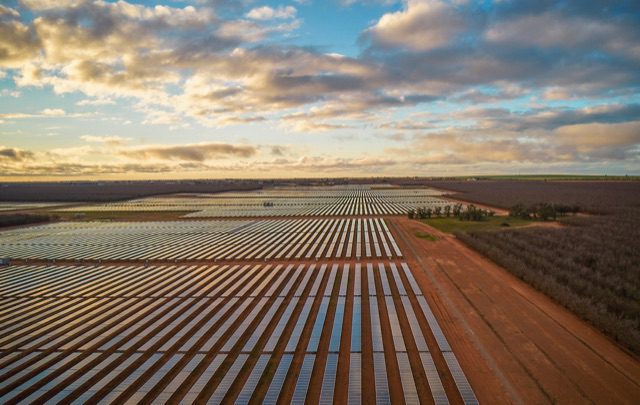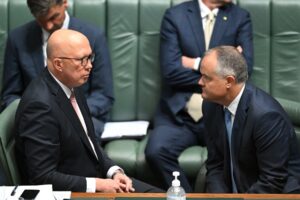It’s entirely possible that the nation’s only financial daily, the Australian Financial Review, is still taken seriously by those interested in its coverage of economic issues. It’s no longer clear why that should continue to be the case.
As David Leitch, a principal at ITK and co-host of Renew Economy’s popular weekly Energy Insiders podcast noted last month, the AFR is a highly respected newspaper. But its coverage of climate and energy, the great economic and environmental issues of our time, has been poor. And it continues to be so.
Its economics editor John Kehoe has served up the paper’s latest take on Australia’s green energy transition. And like previous articles from the AFR, it seems to prove that the conservative echo-chamber is real, deafening, and just a little bit scary.
Here’s my biggest gripe of this latest analysis, which feeds off the scare campaign perpetuated by the fossil fuel industries and ideologues not prepared to accept that renewables and storage are actually a thing.
“After almost 20 years of governments flip-flopping on energy and climate policies, consumers face repeated warnings from the Australian Energy Market Operator (AEMO) about potential future blackouts. It’s an indictment on an energy-rich and wealthy economy,” Kehoe writes.
Let’s stop right there. The Electricity Statement of Opportunities to which Kehoe refers are not blackout warnings. They are an annual publication that identifies where investment opportunities are emerging on the grid. It’s a normal part of business and has been for years.
And yes, the urgency has increased with the expected closure of most of the country’s coal fired power stations over the next decade, but Kehoe’s inference that this would not have occurred had the country chosen nuclear simply doesn’t hold up.
Kehoe is not the only one doing this, of course. It’s the bread and butter of Opposition leader Peter Dutton, and his energy spokesman Ted O’Brien, and the far-right commentators on Murdoch media and talkback radio.
They basically argue that the lights will go out with wind and solar, and they use AEMO’s regular ESOO updates as some sort of “proof” of their position. They suggest that this wouldn’t happen in an economy powered by nuclear.
Really?
Let’s look at Ontario, the nuclear dominated Canadian province – which uses nuclear for more than half of its electricity supply – and which is often held up as a shining example by the federal Coalition, conservative media including Kehoe and energy ideologues as the path that Australia should have followed.
In Ontario, the system operator, known as IESO, publishes its own 10-year forecasts and, like AEMO, has modelled significant shortfalls in the energy supply in coming years. If you want to see a shortfall, Ontario is the place to come.
Are they blackout warnings? No, of course not, no more than AEMO’s forecasts are blackout warnings. But they are a call for action, and for new investment.
The latest IESO planning report notes that its modelled capacity shortfalls were mostly due to repairs and refurbishments required for its nuclear fleet, which will take most of its nuclear capacity offline for periods of up to three years or more.
“Since the last outlook, the IESO has addressed capacity shortfalls that had previously been forecasted for the mid-2020s due to nuclear refurbishments and retirements as well as expiring contracts,” it writes.
“These shortfalls have been filled as a result of Resource Adequacy Framework procurements (which include contracts for big batteries), increased conservation and demand management targets and other government initiatives.”
IESO will continue its auctions of new capacity to make sure that no new shortfalls emerge, just as AEMO and other parties are doing in Australia. But IESO still forecasts a significant shortfall from the end of the decade.
“Over the 2030-2034 period, the APO shows an approximately 5,000 MW and 15 TWh supply shortfall emerging as a result of increasing demand and expiring contracts,” it says.
That’s what the annual planning documents are for. They are for planning. As AEMO has said repeatedly, they are not warnings or forecasts of blackouts. But that doesn’t stop the blackout scare campaign.
As it turns out, Ontario has commissioned construction of two of the world’s biggest batteries, with one of them to be built by Neoen, which is also responsible for the biggest batteries in Australia.
Yes, even nuclear energy requires back up, not that their boosters will ever admit that. They are inflexible and demand to be “always on” so they need something that can absorb excess power when needed, and provide the flexibility when demand jumps around.
It’s why tens of gigawatts of pumped hydro projects were built around the world decades ago, and it is why system operators like IESO are now turning to lithium-ion batteries.
AEMO and the CSIRO are often criticised by the federal Coalition and conservative media for their conclusions that wind, solar and storage are much cheaper than nuclear in Australia. Interestingly, even though the planning report from IESO is focused on conditions in Ontario, it supports their position.
IESO puts that the levellised cost of energy for solar energy in Ontario at $C69/MWh and for wind at $C48/MWh. That’s comparable to Australia, if you swap the wind and solar numbers, because Australia has better solar conditions and that means more output and lower prices.
By comparison, IESO puts the LCOE of nuclear at $C140/MWh, which is lower than the CSIRO estimate but then Ontario has a well established industry and regulatory system. But, as the IESO notes, because nuclear is not flexible it also needs back-up in the form of battery storage and other technologies.
The CSIRO and AEMO dial in storage and transmission costs for wind and solar under various scenarios from 60 per cent to 90 per cent, but they do not result in a doubling or trebling of the costs. Instead, they are incremental.
It is interesting to note that the subsidy for nuclear generators in Ontario amounts to more than $C4 billion a year to ensure that they receive an average of $C110/MWh for their output – and that, remember, is for fully depreciated plants that were built up to half a century ago. The refurbishment costs alone are put at $C26 billion in 2017 dollars.
Looking out to 2050, IESO reckons the cost of wind and solar will both fall significantly to around $C33/MWh, but the cost of nuclear will be little changed at $C131/MWh, and that is assuming an “always on” capacity factor of 93 per cent, which energy analysts say would be impossible in Australia because of the amount of solar power during the day.
IESO also puts the cost of SMRs at around the same as large scale nuclear, but that remains to be seen, and there is talk that the Canadian SMR projects are running into the very same cost issues that have derailed the Nuscale SMR project in the US, and the SMR plans by French nuclear giant EdF.










